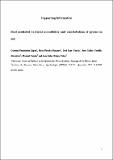Por favor, use este identificador para citar o enlazar a este item:
http://hdl.handle.net/10261/224354COMPARTIR / EXPORTAR:
 SHARE SHARE
 CORE
BASE CORE
BASE
|
|
| Visualizar otros formatos: MARC | Dublin Core | RDF | ORE | MODS | METS | DIDL | DATACITE | |

| Título: | Root-mediated bacterial accessibility and cometabolism of pyrene in soil |
Autor: | Fernández-López, Carmen; Posada Baquero, Rosa CSIC ORCID; García Fernández, José Luis CSIC ORCID ; Castilla-Alcántara, José Carlos CSIC ORCID; Cantos, Manuel CSIC ORCID ; Ortega Calvo, J. J. CSIC ORCID | Palabras clave: | Bacteria Biodegradation Bioremediation Polycyclic aromatic hydrocarbons Sunflower |
Fecha de publicación: | 15-mar-2021 | Editor: | Elsevier | Citación: | Science of The Total Environment (760): 143408 (2021) | Resumen: | Partial transformation of pollutants and mobilization of the produced metabolites may contribute significantly to the risks resulting from biological treatment of soils polluted by hydrophobic chemicals such as polycyclic aromatic hydrocarbons (PAHs). Pyrene, a four-ringed PAH, was selected here as a model pollutant to study the effects of sunflower plants on the bacterial accessibility and cometabolism of this pollutant when located at a spatially distant source within soil. We compared the transformation of passively dosed 14C-labeled pyrene in soil slurries and planted pots that were inoculated with the bacterium Pseudomonas putida G7. This bacterium combines flagellar cell motility with the ability to cometabolically transform pyrene. Cometabolism of this PAH occurred immediately in the inoculated and shaken soil slurries, where the bacteria had full access to the passive dosing devices (silicone O-rings). Root exudates did not enhance the survival of P. putida G7 cells in soil slurries, but doubled their transport in column tests. In greenhouse-incubated soil pots with the same pyrene sources instead located centimeters from the soil surface, the inoculated bacteria transformed 14C-labeled pyrene only when the pots were planted with sunflowers. Bacterial inoculation caused mobilization of 14C-labeled pyrene metabolites into the leachates of the planted pots at concentrations of approximately 1 mg L−1, ten times greater than the water solubility of the parent compound. This mobilization resulted in a doubled specific root uptake rate of 14C-labeled pyrene equivalents and a significantly decreased root-to-fruit transfer rate. Our results show that the plants facilitated bacterial access to the distant pollutant source, possibly by increasing bacterial dispersal in the soil; this increased bacterial access was associated with cometabolism, which contributed to the risks of biodegradation. © 2020 Elsevier B.V. | Descripción: | 13 páginas.-- 6 figuras.- 1 tablas.- 43 referencias.- Supplementary data to this article can be found online at https://doi.org/10.1016/j.scitotenv.2020.143408 | Versión del editor: | http://dx.doi.org/10.1016/j.scitotenv.2020.143408 | URI: | http://hdl.handle.net/10261/224354 | DOI: | 10.1016/j.scitotenv.2020.143408 | ISSN: | 0048-9697 |
| Aparece en las colecciones: | (IRNAS) Artículos |
Ficheros en este ítem:
| Fichero | Descripción | Tamaño | Formato | |
|---|---|---|---|---|
| Root_mediated_bacterial_2021_Postprint.pdf | 1,5 MB | Adobe PDF |  Visualizar/Abrir | |
| Root_mediated_bacterial_SUPORTIN_INFORMATION_2021_Postprint.pdf | 550,35 kB | Adobe PDF |  Visualizar/Abrir |
CORE Recommender
SCOPUSTM
Citations
17
checked on 22-abr-2024
WEB OF SCIENCETM
Citations
14
checked on 25-feb-2024
Page view(s)
177
checked on 24-abr-2024
Download(s)
48
checked on 24-abr-2024
Google ScholarTM
Check
Altmetric
Altmetric
NOTA: Los ítems de Digital.CSIC están protegidos por copyright, con todos los derechos reservados, a menos que se indique lo contrario.
